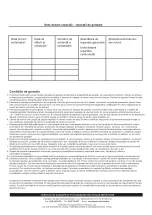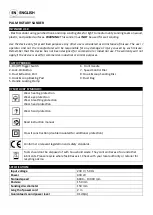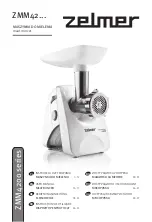
ADJUSTING TOOL SPEED
-This sander features variable speed control that enables it to be used with a variety of different materials,
workpieces and objects
1. Adjust the Speed Control Dial (7) on to a higher number, to increase the tool speed
2. Adjust the Speed Control Dial on to a lower number, to decrease the tool speed
- If in doubt about the correct speed setting, suitable for the task at hand, start with a low speed, examine
the results, and adjust to a higher setting if necessary
SANDING TIPS
- If the tool is connected to a vacuum dust extraction system, switch the extraction device on before
switching on the sander. Switch the sander off first, then the vacuum system
- Move the machine in a circular motion over the workpiece surface, applying an even, moderate pressure
until you reach the desired surface finish
WARNING:
Excessive pressure does not lead to a faster removal of material; it will however lead to
premature wear of the sanding sheet, and may cause damage to the machine. Both sanding performance
and quality depend mainly on the choice of the correct sanding discs.
- If there are still scratches on your workpiece after sanding, refer to ‘Selecting the right grade of sanding
sheet’
MAINTENANCE:
..........................................................................................................................................
- Regularly check that all the fixing screws are tight. They may vibrate loose over time
- Inspect the supply cord of the tool, prior to each use, for damage or wear. Repairs should be carried out
by an authorised service centre. This advice also applies to extension cords used with this tool
CLEANING
WARNING:
ALWAYS
wear protective equipment including eye protection and gloves when cleaning this
tool.
- Keep your tool clean at all times. Dirt and dust will cause internal parts to wear quickly, and shorten the
device’s service life
- Clean the body of your machine with a soft brush, or dry cloth
- Never use caustic agents to clean plastic parts. If dry cleaning is not sufficient, a mild detergent on a damp
cloth is recommended
- Water must never come into contact with the tool
- Ensure the tool is thoroughly dry before using it
- If available, use clean, dry, compressed air to blow through the ventilation holes (where applicable)
STORAGE
- Store this tool carefully in a secure, dry place out of the reach of children
HOOK AND LOOP SURFACES
- Hook and loop surfaces need to be clean, free of dirt and foreign matter, such as hair, fibers, sand etc.
-In order to provide adequate adhesion for securing accessories, hook and loop surfaces must be in good
condition
-When used extensively, hooks and loops will become elongated or broken, and the mechanism cannot
provide the required strength of adhesion anymore
Note
: This sander’s hook and loop sanding base is NOT a warranty item. Replacement plates can be fitted
at an authorized service center.



































